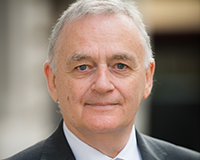 My otherwise gentle art teacher was prone to abrupt acts of violence. Mr Holness would steal up unawares behind two chattering pupils, reach out with both hands and haul the pair up by the earlobes, their eyes bulging like frightened colts. Retaining a firm pinch, he’d bang their heads together, bellowing: “You will not talk in class!” Bang. “Do you understand?” Bang. “Sit down!” Final bang.
My otherwise gentle art teacher was prone to abrupt acts of violence. Mr Holness would steal up unawares behind two chattering pupils, reach out with both hands and haul the pair up by the earlobes, their eyes bulging like frightened colts. Retaining a firm pinch, he’d bang their heads together, bellowing: “You will not talk in class!” Bang. “Do you understand?” Bang. “Sit down!” Final bang.
The desire to inflict similar humiliation on David Cameron and Ed Miliband surfaced last week. I could barely contain my irritation after watching the pair boast about how many homes they will build, if elected. “Politicians are not bricklayers!” Bang. “Housebuilders build homes!” Bang. “The number they build is dictated by hard economics, not soft political philosophy.” Final bang.
On 14 June last year I was mildly annoyed. The rate at which new homes are built is determined by housebuilders acting individually, not by the collective will of target-setting governments. Now, helpless fury engulfs. Exchange new homes for new cars to see how perverse it is for politicians to assume responsibility for what is clearly the arena of a shrunken group of volume housebuilders.
Last year 118,000 new homes were built, 94,000 of them by the private sector. This year 130,000 or so will be completed, around 100,000 by housebuilders. That’s my guess. A series of further guesses can be made by reading the latest financial statements of the top 10 builders: they will complete around 70,000 units in 2015, or 55% of the 130,000 new homes, a market share up 20% on 2005.
The Group of Ten have landbanks with permission to build 329,023 homes – 4.7 years’ supply at a rate of 70,000 a year. The GOT also hold options on land, enabling them to build almost as many again. The biggest, Barratt, has 68,937 plots plus 11,000 acres of strategic land. The smallest, Countrywide, holds 13,408 plots with permission, 10,582 without. The GOT effectively controls supply.
Yet politicians blithely promise up to 220,000 new homes per year by 2020. That’s 90,000 on top of the 130,000 predicted for 2015. The GOT need to supply 55% of those extra 90,000 units to maintain market share. An extra 50,000 on top of 70,000 they may build this year. The idea that this will happen because politicians say it must is ludicrous. It might happen, but only if it suits the economic interests of the GOT.
Timing is everything
Carlyle has creamed £200m from the sale of six bust office blocks bought for £700m in 2010, a profit the US fund crystallised last month with the £300m sale of Samson House and Ludgate House in Blackfriars, SE1.
Buyer Native Land is now to take forward a 500-unit Thames-side development worked up by Carlyle.
Congratulations to Carlyle for buying in 2010 and selling in 2015. Best of luck to Native Land boss Alasdair Nicholls and his backers for embarking on what is surely a five-year programme. Five years without a crash is one thing, 10 years is perhaps pushing your luck with something of this size.
Culture clash
Chinese developer Greenland has imported a stack of staff from China to work through projects in London, including the Ram Brewery site in Wandsworth and the UK’s tallest residential tower in Docklands. How’s it going? Not well, say chortling agents, who suggest Greenland really ought to appoint UK advisers to show it how things work in Britain. Self interest – or the truth?
Dellal’s lucky loss
“Black” Jack Dellal’s widow Ruanne, 61, alleges the property magnate short-changed her in his will, leaving her £15m, rather than £50m.
The tale has been spread through the press in glorious detail, including a snippet on how Dellal lost £1.7m in one night at the gaming tables.
However, he did have one unreported stroke of luck. In 2002 Dellal offered £100m for Dolphin Square. Given that the rental block appears in the press every time the Cyril Smith scandal comes up, his widow is lucky his offer was rejected. What current owner Westbrook must feel can only be imagined.










